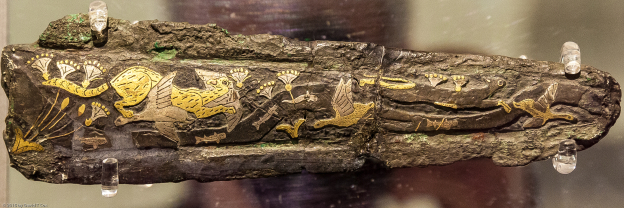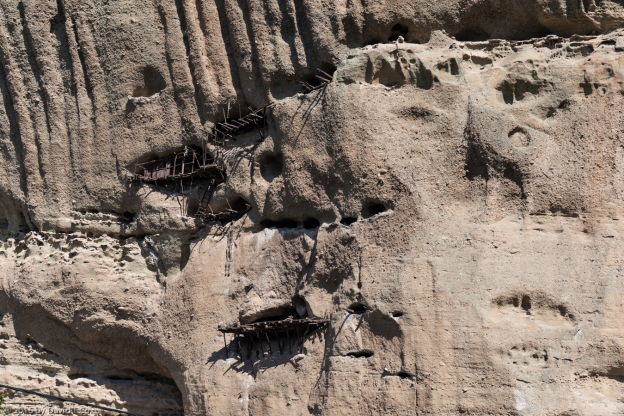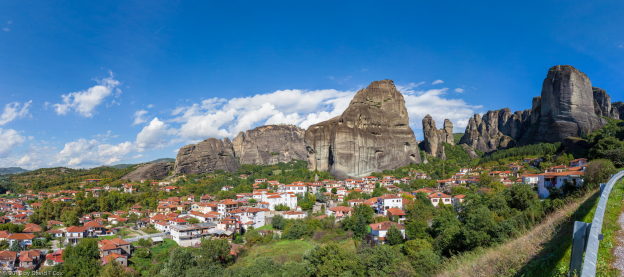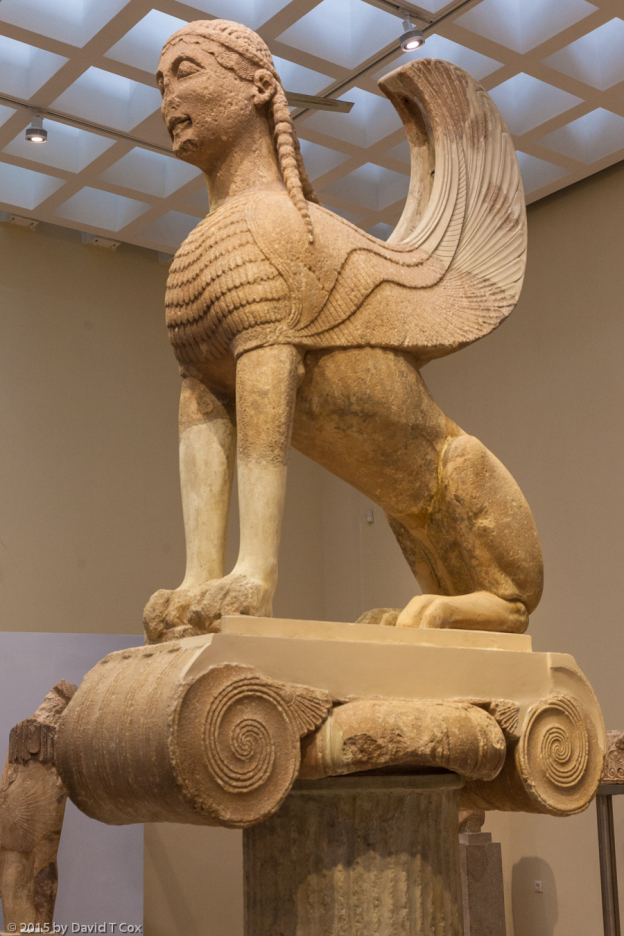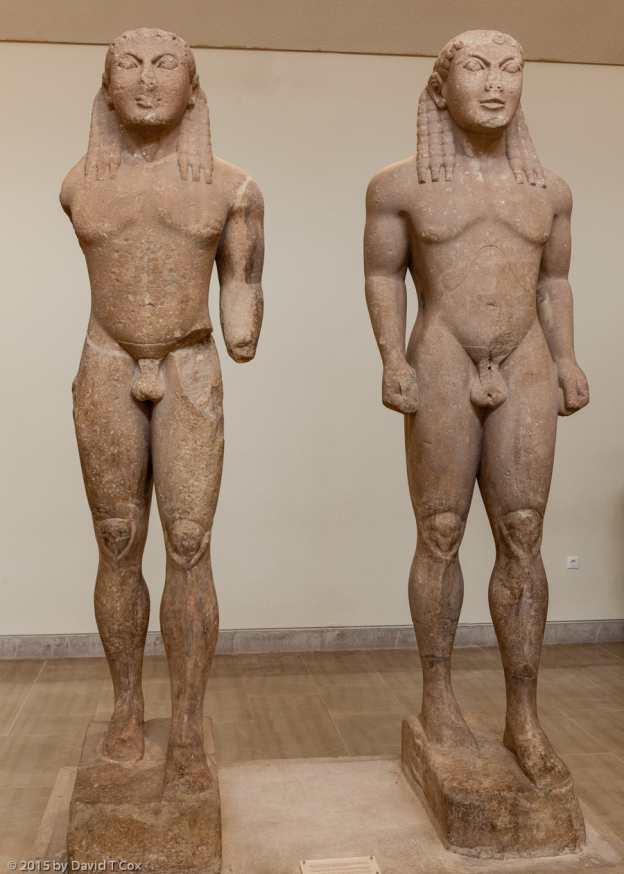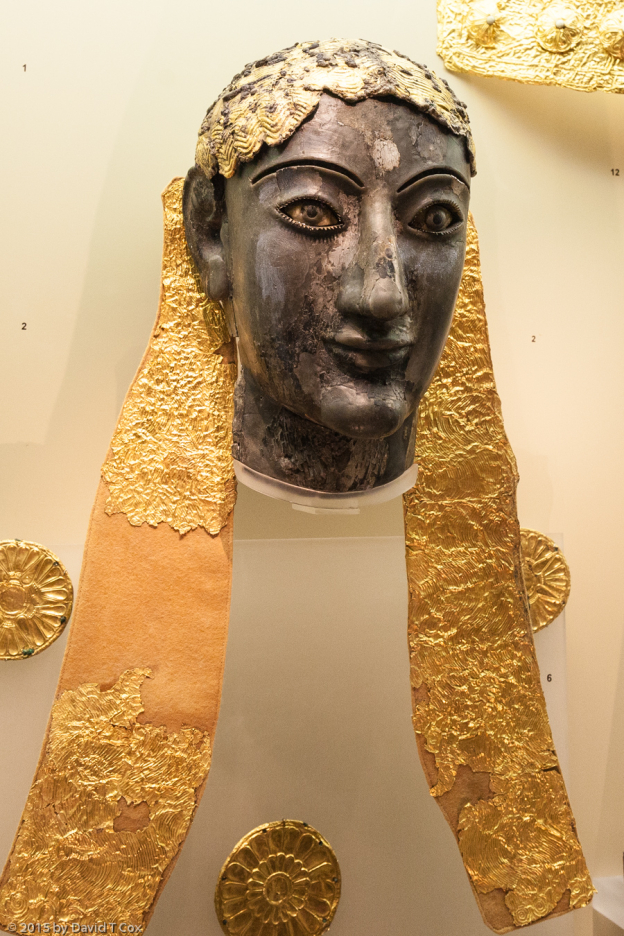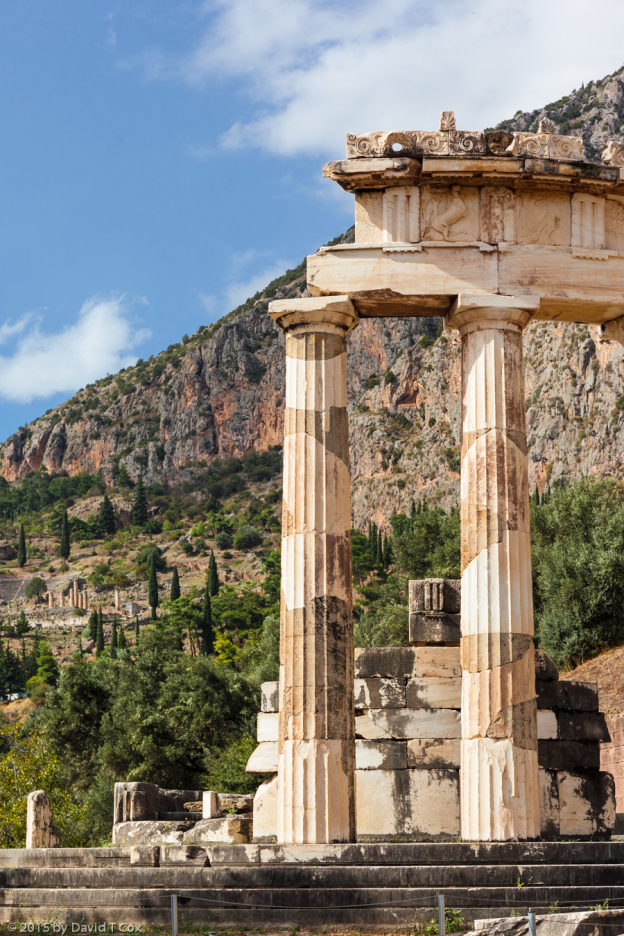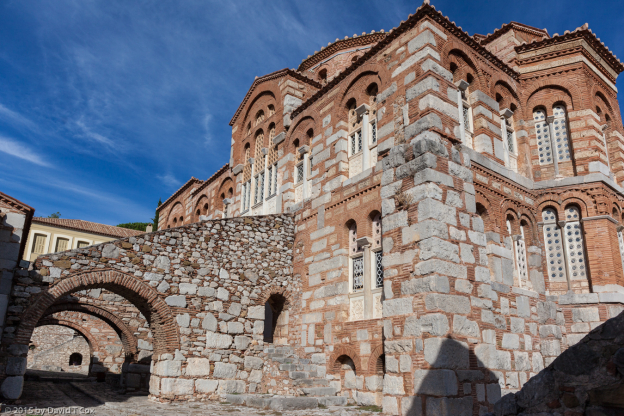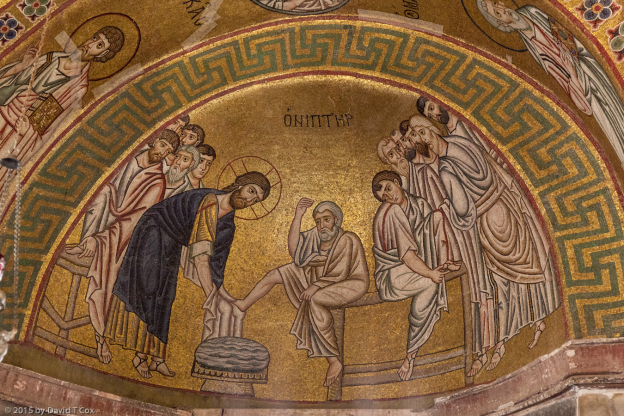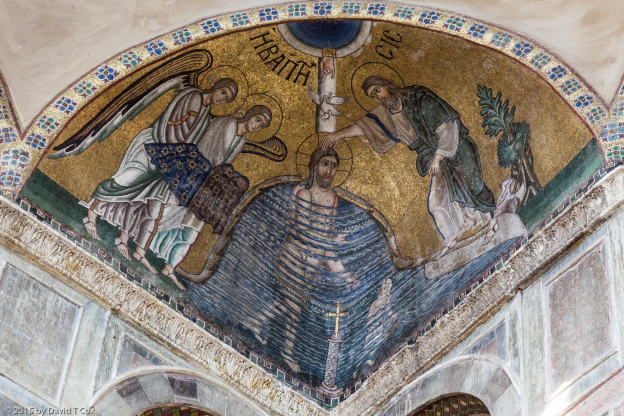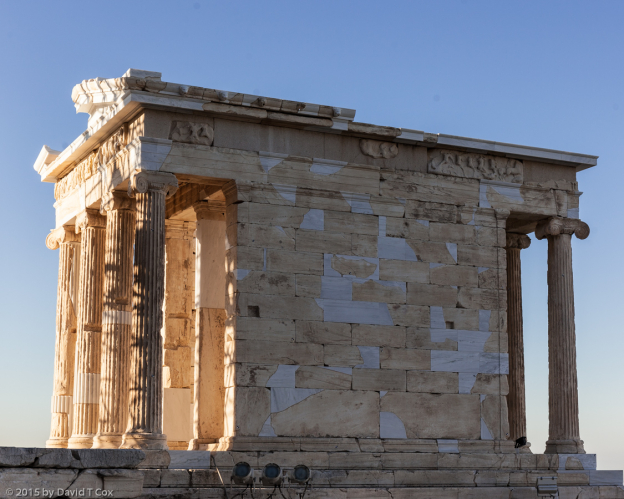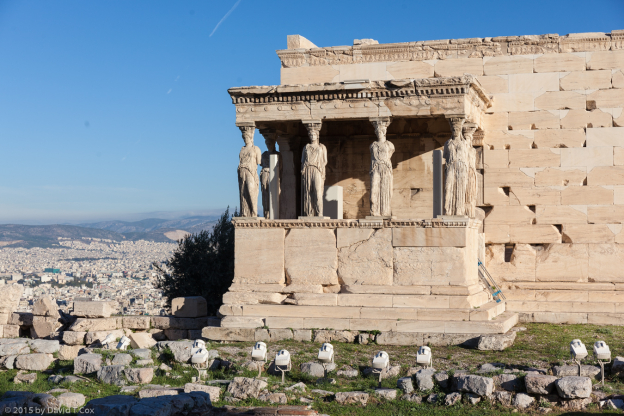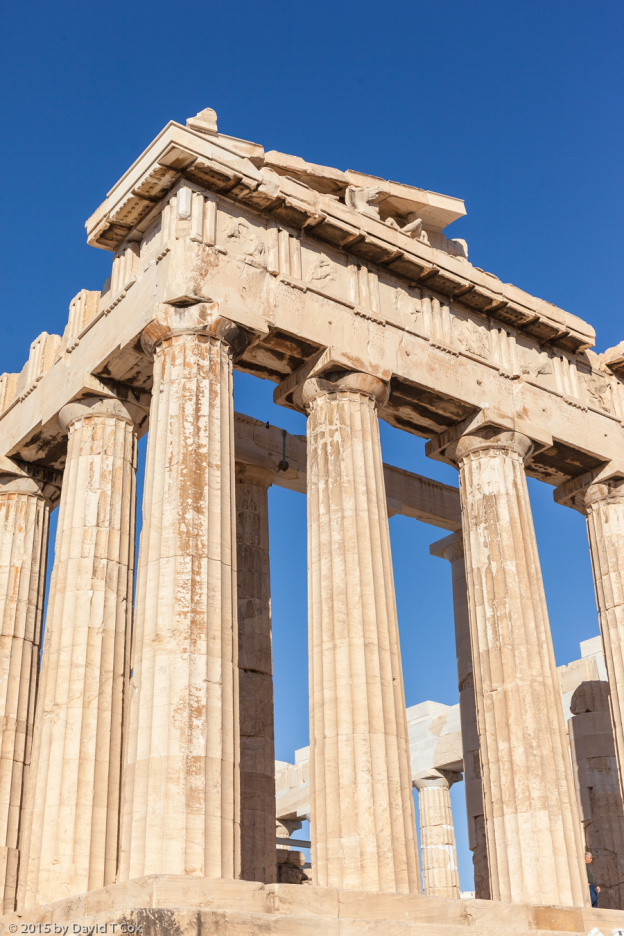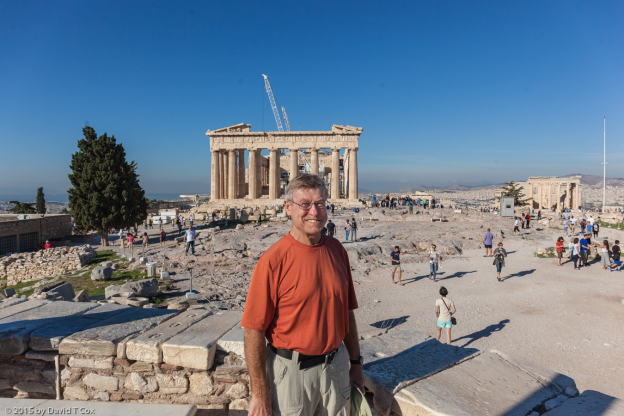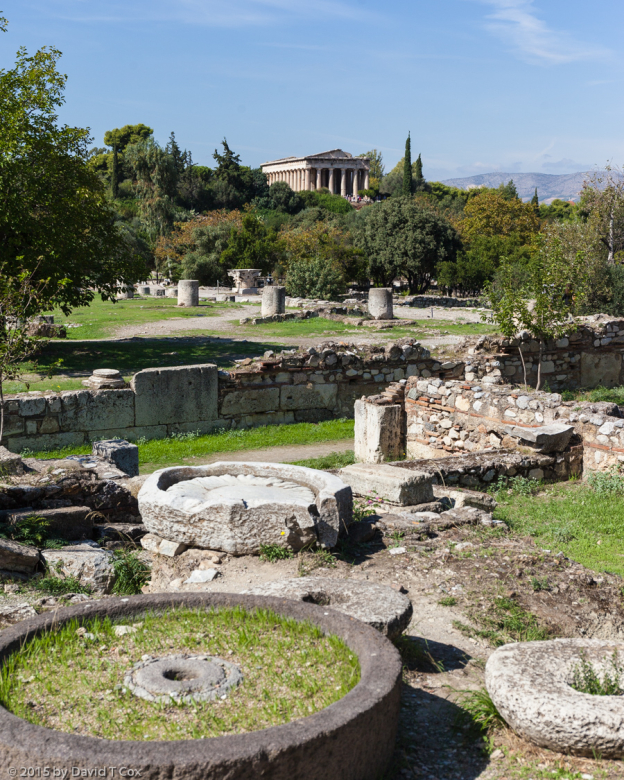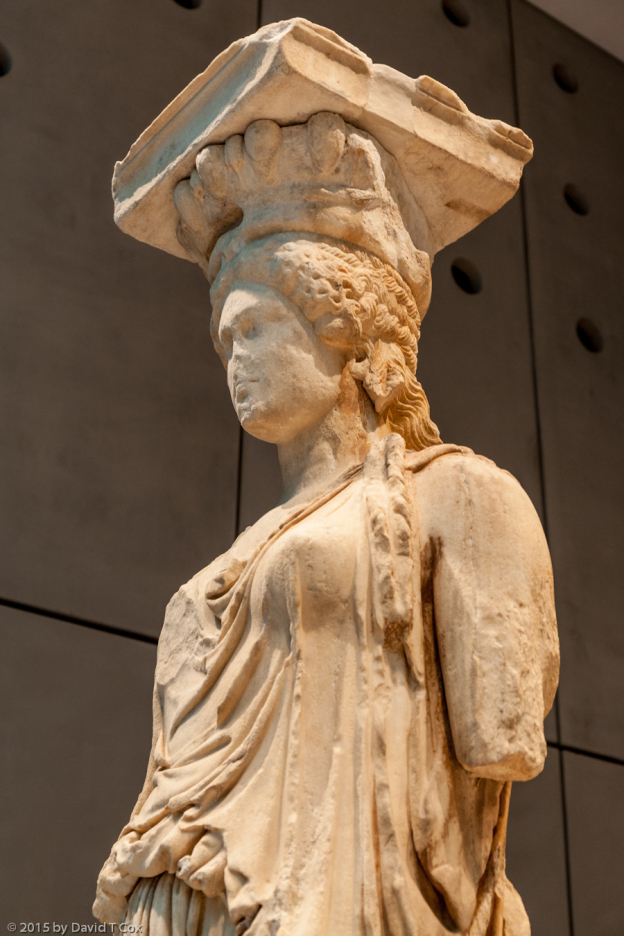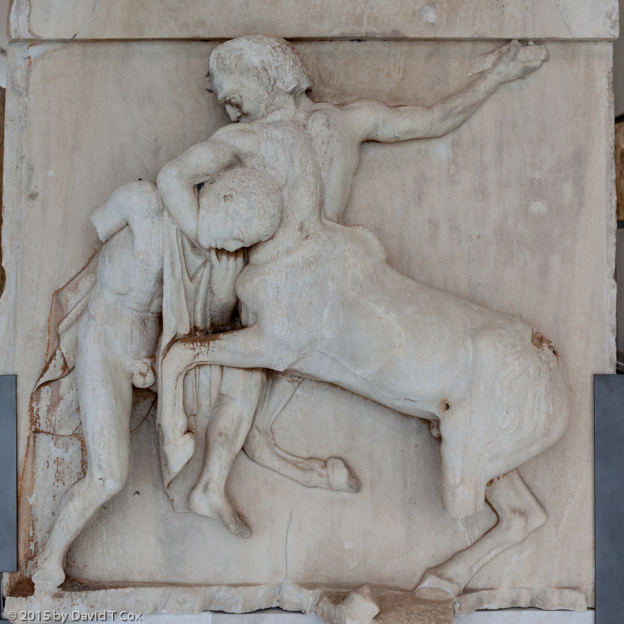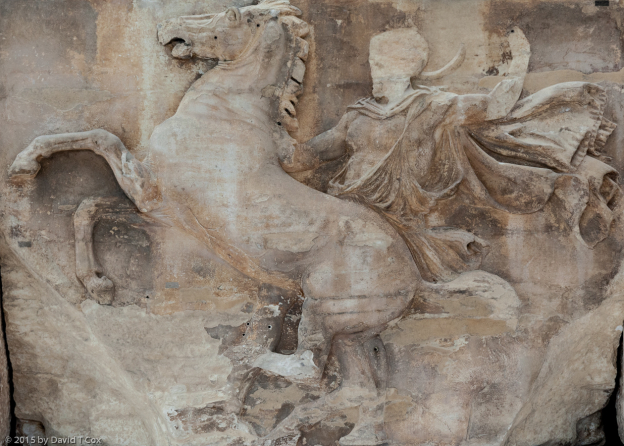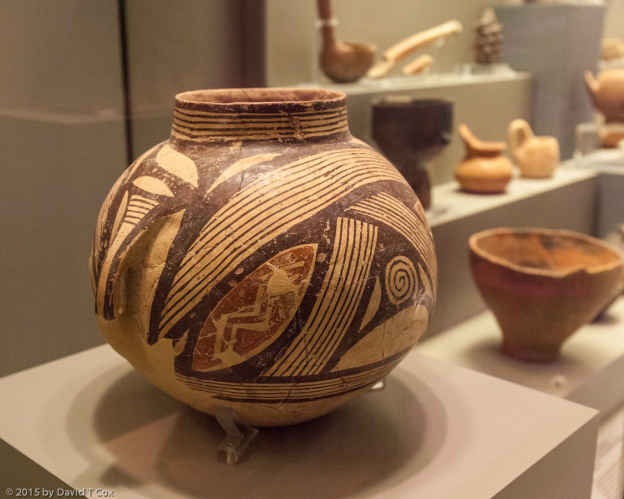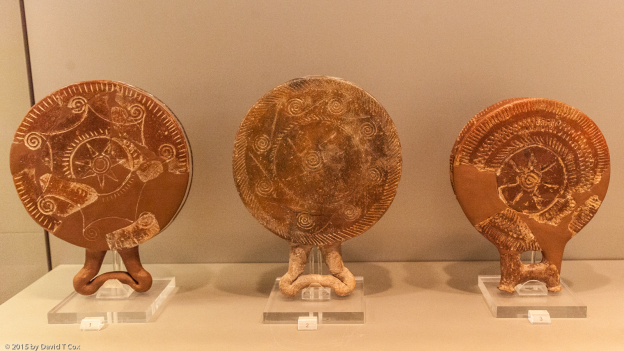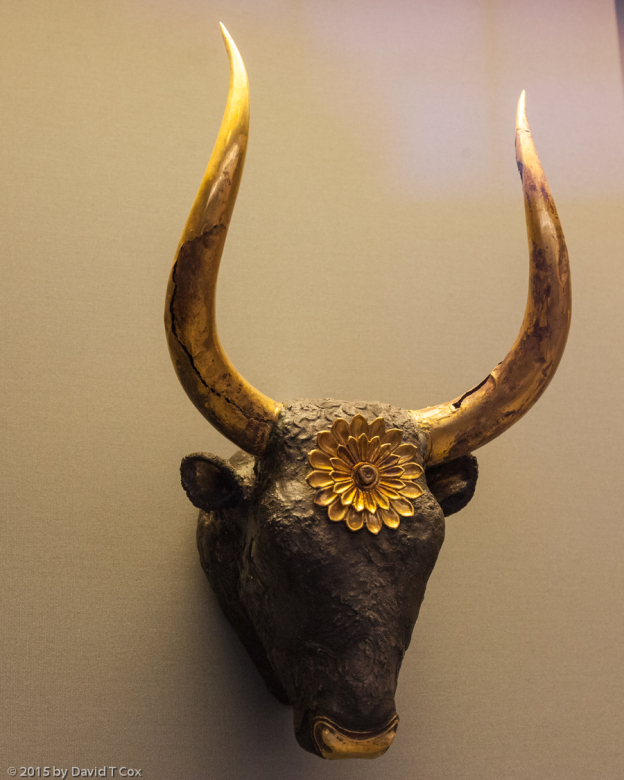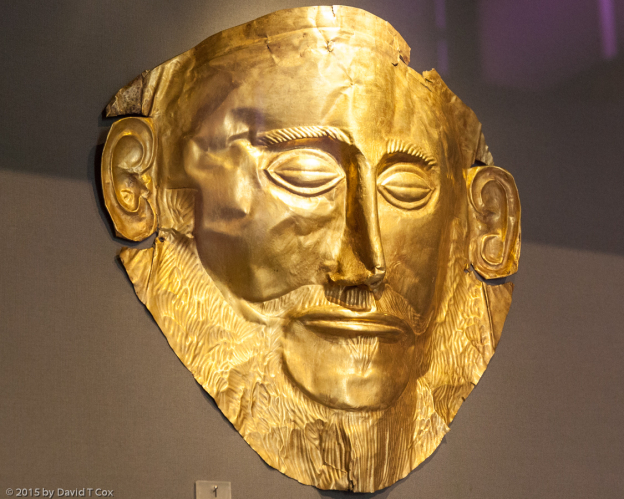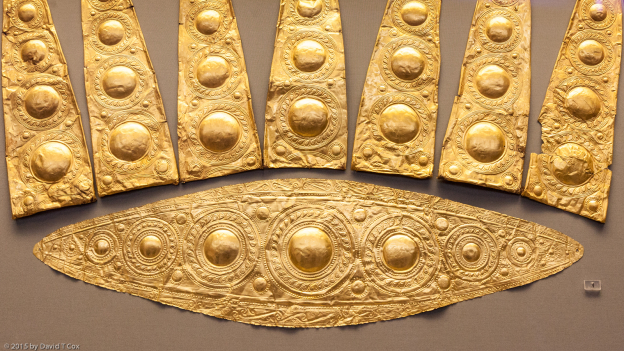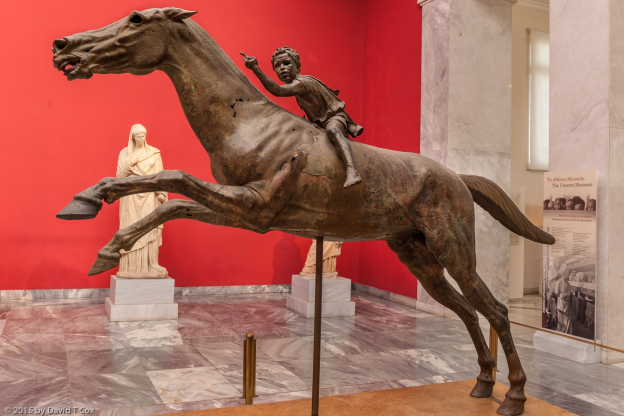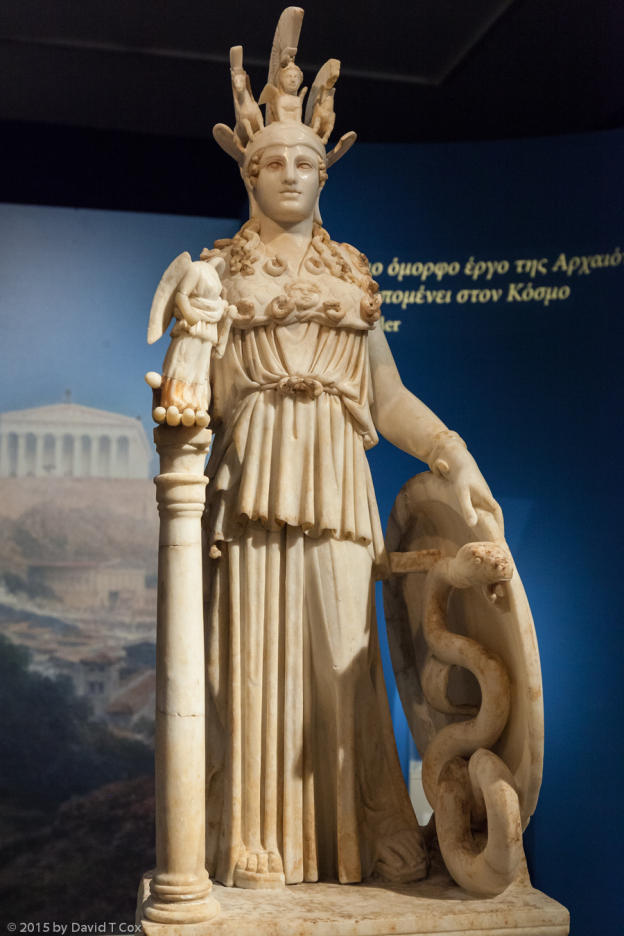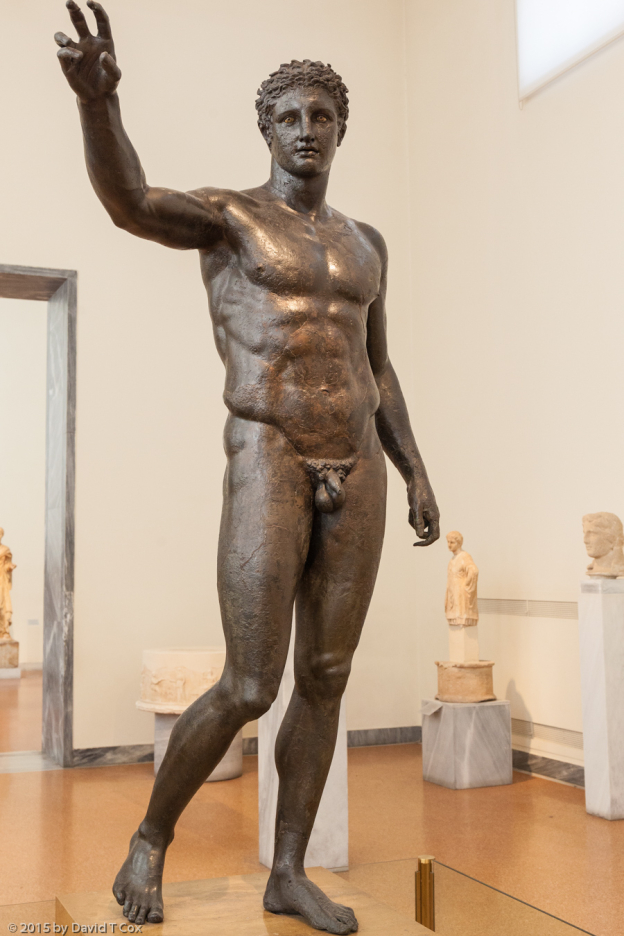All Photos Are Below the Travelogue Text
Click on Any Photo To Open Slide Show
To print the travelogue, right click anywhere on the page. Choose "Print" from your browser dialog box. You can choose Save to PDF in the browser print window.
Share your thoughts.
Email Dave - coxdavid55@hotmail.com
My last day in Meteora, the other-worldly site of 14th century monasteries perched upon the rock pillars, I hiked up a short canyon around the base of several pillars to view ruins of some old monastic dwellings in caves, including what are referred to as hermitages. Some of the rock pillars have small caves, alcoves and cracks into the rock face, ranging from 40 to over a hundred feet up the pillar’s wall. Within a number of these openings, religious hermits constructed wooden platforms and railings, often on multiple levels connected by rickety ladders; they apparently lived out their lives here partially exposed to the elements (see photo below). I took also one last panoramic photo (actually a composite of over 60 photos) of the Meteora from the south with Kastraki in the valley below; two monateries are visible perched upon high pinacles, but appear tiny in the photo.
On Saturday 9 days ago I traveled from Kalambaka by bus to Delphi, site of the Sacred Sanctuary Precinct of the Oracle of archaic and classical Greece. The travel, although not far in distance, occupied much of the day as I had to board 4 different buses to make the journey. The modern town of Delphi, which exists solely to provide tourist services to those who visit, consists of several parallel streets running around the edge of a steep mountainside, one above the other, overlooking a deep olive grove filled valley with the Bay of Corinth to the southwest. Nice view from my hotel balcony.
Just around the corner of the mountain to the east, on a steep slope under the western end of the rocky ridge that rises into Mt Parnassus, lies the Sacred Precinct of Delphi. From the late Bronze Age through the early Roman-Greco period, this was a most sacred place where people came to seek prophesies and advice concerning all manner of life questions, from whether engaging in war would destroy an empire to prospects for successful marriages. These prophesies, rendered by priests and conveyed to the seekers in metered rhyme, first were interpreted from the ravings of the sibyl or priestess, known as the Pythia, an elderly, “blameless” woman who sat over an opening in the earth within the Temple of Apollo, breathing rising fumes of perhaps ethylene or burning oleander (either somewhat toxic and probably producing trances). Delphi also was the site, every four years, of the Pythian Games, archaic period predecessor to the Panathenaic Games at Olympia and, much later, the modern Olympics.
For the Oracle and the Pythian Games, the Sacred Precinct was filled with temples, sanctuaries, treasuries, theaters, stadiums and monuments, constructed by the powerful city-states and surrounding kingdoms of the time. Though much of the site itself now is not much more than foundations, having suffered through a number of huge earthquakes, sackings and fires, the site museum contains some remarkable finds – to my eye the most spectacular the three restored life-size chryselephantine statues, produced in the late Archaic Period (6th-5th C BC), found in the “Repositories” in front of the Stoa of the Athenians. The adjective “chryselephantine” derives from the Greek words for gold and ivory, and so denotes objects made of gold and ivory. Chryselephantine statues of people or gods were carved wooden bodies completely covered with gold, except for all exposed “skin” parts which were carved of ivory (the face, arms, hands and feet). See my pictures of the two outstanding chryselephantine statues’ heads – the ivory faces somewhat blackened from the offering fire with which they were buried millennia ago. Also see the bronze “Charioteer”, from the Archaic-Classical boundary around 480 BC, the first and perhaps the most famous of the handful of great life-size Classical bronzes ever found. It was preserved intact in a deep burial resulting from an earthquake in 373 BC, though almost all of the attached bronze chariot and horses were looted millennia ago. Finally see the marble statue of the Sphinx, which the powerful kingdom of the island of Naxos offered to Delphi around 560 BC during the Archaic Period, sitting atop a 40 foot pillar.
From Delphi I made a day trip by taxi to the Byzantine Monastery of Osios Loukas, built in the 11th century. The larger of the two Monastery churches, the Katholikon, is famed for its well-preserved Byzantine mosaics, considered by many the best in all of Greece. The Monastery, unlike those at Meteora, sits on the side of a low mountain overlooking a green valley. I have included several photos of the mosaics, most of which are within concave curved surfaces giving them a special dimensionality. Within the crypt under the church are a number of well-preserved frescoes, particularly on the ceiling.
On Wednesday last I traveled from Delphi to Athens – exactly 4 weeks to the day after arrival in Greece, I finally arrive in its main city. I am ensconced in a fine little hotel called the Acropolis House, known for providing mid-term stays for various students and professors of the classics; it is located in the heart of the area know as the Plaka, within walking distance of just about all of importance, including the Acropolis and Ancient Agora.
My first full day I toured the Acropolis and Agoras (Ancient & Roman), the “must-sees” for any visit to Greece. The Acropolis, for those who have not visited, is a rocky hill rising straight up sheer cliffs over 200 feet above the level of the surrounding ancient city of Athens. The top is approximately flat, mesa-like, about 1000 feet long and half as wide. Below the cliff face of all sides the talus is covered with dirt forming sloping areas – various ruins of sanctuaries, temples, theaters and stoa occupy the lower these dirt-covered talus fields, particularly below the southern cliff face. An ancient causeway, now converted to trails and stairs, provides access to the top from the west. At the top, today, survive just four Classic Period Greek structures, set among older foundational ruins. One enters through the great pillars and halls of the Propylaia on the western end. It shelters and hides the very small but beautiful Temple of Athena Nike which sits right on the southwestern corner over the cliff-face. On the northern side of the Acropolis sits the Erechtheion and its famous Porch of the Caryatids. Finally, at the center south, and the highest point, towers the monumental Parthenon, much larger than the presentation provided by pictures.
Unfortunately and, to my mind, obscenely, practically the entirety of the views of the Propylaia, the Temple of Athena Nike and the Parthenon are marred by scaffolding, work-crews, canvas and giant cranes. Further, on the southern approach, the Sanctuary and the Temple of Asclepion, the Stoa of Eumenes II and the Theater of Herodus Atticus and its entire stage are roped off with scaffolding and work equipment. I understand some reconstruction and repair work was initiated to be completed in time for the 2004 Olympic Games held in Athens; that work apparently has now been ongoing continuously for 15 years, with expectations it may go on for that much longer into the future. Restoration and consolidation work on the world’s great monuments is necessary and understandable – but ordinarily this is done on small segments at a time so as not to mar the entirety of a World Heritage site for decades. I suppose the economic crisis has resulted both in reduced government funding available at the same time the government is trying to employ more for public works. By my calculation, the only photos in existence of the entire Parthenon, unblemished by scaffolding and cranes, are photos taken on film – no digital photos of a clean Parthenon exist. Still, for all my complaining, the overall impression of the towering structure is exhilarating.
In ancient time, the eastern, larger, chamber of the Parthenon served as a Temple to Athena, and contained a 40 foot chryselephantine statue of the Goddess known as the Athena Parthenos. The gold used to cover the statue was recorded to weigh 2,400 lbs. (in round numbers worth about $50,000,000 today), and accounted for a substantial portion of Athens’ Treasury, which was housed in the smaller chamber at the west end of the Parthenon. The statue was constructed around 447 BC, but had its gold removed around 390 BC in order to be able to afford to pay troops (the statue thereafter covered with gold-covered bronze plates). Over a millennium later the statue apparently was moved to Constantinople, but since has disappeared.
The much smaller structure called the Erechtheion, to the north, is the only building now without reconstruction obscuring its beauty. The east and west ends have the roof supported by Ionic columns. On the southwestern side is a lower porch extending out from the building with its roof famously supported by six statues of women known as the Caryatids; the original statues now are displayed in the nearby wonderful Museum of the Acropolis – see the included photo. The Museum also displays remaining fragments of the pediments, metopes and friezes of the Parthenon, the sculptured architectural details at both ends and around the roof edges of the building. The frieze, which extended around all four sides of the inner structure, was 524 feet long, and the entirety displayed a massive procession, perhaps the Panathenaic Procession, starting at the southwest corner of the Parthenon and extending both directions around the building to end at the eastern entrance. Although the majority of the remaining parts of the frieze were hauled off by Lord Byron 200 years ago, and now sit in the British Museum, many of the great scenes of the horsemen are displayed in the Acropolis Museum, of which I have included sample photos.
Below the Acropolis, on the slopes of the north side, lies the Ancient Agora, or public gathering place and marketplace, of Athens, with the beautiful Temple of Hephaistus and various Stoa among other structures. The completely rebuilt Stoa of Attalos now contains the Site Museum for the objects found in the Ancient Agora, mostly funerary ceramic items from the many burials found in this area.
Yesterday I finally got to visit one of the world’s great archeological museums which I so far have missed, the National Archeological Museum of Greece. Unlike the regional and site museums I already have visited, this museum covers, of course, the entire archeological record of the ancient Greek world. Interestingly, this coverage comes to a chronological conclusion with just a relatively small collection of late Hellenistic and Roman artifacts, and no Byzantine coverage at all; those periods are considered well into the historical rather than archeological record. I spent six solid hours on my feet within the museum’s halls, and kept finding rooms I had missed. I am quite sure I still have missed much, and hurried past most, and hope to return before leaving Greece.
Among the museum highlights are – 4 life-size bronze statues of the Greek Classical Period, including a very young jockey riding a very large galloping horse, recovered from the sea from an ancient shipwreck – a huge collection of marble statues and grave markers, extraordinary pottery – and, most popular, the many finds of the famous 19th century German, Heinrich Schliemann. Schliemann was the famous pioneer who insisted the major actions and places recounted in the Iliad, the story of the Trojan War between Troy and Mycenae, were not myth but real historical references. He proceeded then to locate both Troy, near the western Dardanelles in northwest Turkey, and the 16th–12th century BC Mycenaean Capital in the Peloponnese of Greece.
A brief digression to put Greek ancient history in very rough perspective. Greece had not one, but two separate eras which saw great flowering of the arts and construction of monuments. The latter, from about 700 to 323 BC, was referred to as the Archaic and Classic Periods; these periods saw the production of the city states, democracy, the great philosophers and playwrights, along with the bronze and marble sculptures, fine ceramics and the written classics. Prior to these periods was a 400 year gap sometimes referred to as the Greek Dark Ages, during which little development and no writings are found (possibly a result of not digging in the right places). Prior to the Dark Ages, from 2500 to about 1100 BC, a millennia before Classic Greece, two great civilizations emerged and ultimately merged; first was the great Minoan civilization of Crete, followed by and ultimately merged into by the great Mycenaean civilization from the Peloponnese. From this period two forms of writing was developed, the latter of which which morphed into ancient Greek. The Mycenaean/Minoan merged civilization of the 16th through the 12th centuries BC comprised the canvas upon which the mythic heroes and gods of Greece roamed and played out their stories. During the early 12th century BC the Mycenaeans apparently fought a real war with Troy, the archeological remnants of which are present at Troy.
From excavations in the Mycenaean capital, Schliemann unearthed a mass of precious artifacts and relics, including a very large number of fantastic gold objects. See the picture of the famous death “Mask of Agamemnon”, though whose royal corpse it actually covered is unknown. My favorite Mycenaean artifact is a fragment of a bronze dagger, perhaps 5 inches long, the side inlaid with gold and silver to portray an amazing tiny and intricate scene of two felines chasing through flying ducks, running over a watery patch with fish and papyrus reed flowers. Consider that the view of attached photo on an ordinary monitor screen displays the blade at about twice life-size.
Also a museum highlight, the statue of Athena Parthenos, a marble copy (called the “Varvekeion Copy”) of the original Chryselephantine statue, which at 1 meter (1/12 size) still gives some sense of the awesome presence the original must have instilled in the Parthenon. I have included photos also of a large decorated spherical clay vase from Dimini, which astounded me by the fact it is 7,000 years old, and Cycladic (from the Island group of that name) clay vessels from the early bronze age (2800-2300 BC) called “frying pans,” a reference to their shape although their use is unknown.
I am taking a few days breather to catch up on captioning photos, and am researching how best to attack my visits to the Peloponnese and islands. Some have inquired why I include no bird and wildlife photos; for this trip I chose not to bring a heavy telephoto lens for bird shots, partially to reduce the weight I carry, but also because Europe just does not have the wealth of bird diversity found in other continents; this trip is for the archeology. The food and red wine continues to be good, and I enjoy my late afternoons sitting on my little balcony reading sci-fi and drinking the red.
Later. Dave
- Hermitage ruins of Agios Grigorios, Agios Christomas & Agios Antonios, Meteora, Greece
- Meteora-Kastraki Pano 3, Greece
- marble Sphinx from the Column of Naxos, 570-560 BC, Delphi Site Museum, Greece
- “Twins” of Argos, heroic size votive offerings, ca 580 BC, Delphi Site Museum, Greece
- bronze “Charioteer”, part of life-size horse drawn chariot, archaic – classical transition, 480-460 BC, Delphi Site Museum, Greece
- parts of female chryselephantine statue, ivory head (wax repairs) w inlaid eyes and eyelashes, gold & silver detail, part of offerings found in Repositories in front of Stoa of Athenians, most produced by Ionian workshops, prob Samos, 6th C BC, Delphi Stie Museum, Greece
- parts of male chryselephantine statue, ivory head (wax repairs) w inlaid eyes and eyelashes, gold & silver detail, part of offerings found in Repositories in front of Stoa of Athenians, most produced by Ionian workshops, 6th-5th C BC, Delphi Stie Museum, Greece
- Delphi view down to Theater & Temple of Apollo w Athena Pronaia Sancturary in distance, Delphi, Greece
- The Tholos, ca 380 BC, at Sanctuary of Athena Pronaia, 4th C BC, Delphi, Greece
- Osios Loukas Monastery, Katholikon Church, Byzantine, 11th C, Greece
- Mosaic Jesus washing desciples feet, Osios Loukas Monastery, Katholikon Church, Byzantine, 11th C, Greece
- Mosaic, Osios Loukas Monastery, Katholikon Church, Byzantine, 11th C, Greece
- Temple of Athena Nike, Acropolis, Athens, Greece
- Porch of the Caryatids, Erechtheion, Acropolis, Athens, Greece
- Parthenon, Acropolis, Athens, Greece
- photographer before Parthenon, Acropolis, Athens, Greece
- Ancient Agora & Hephaistos Temple, Athens, Greece
- The Caryatids, from south porch of Erechtheion, Acropolis Site Museum, Athens, Greece
- Parthenon south side Metope, Centaur battles Greek, Acropolis Site Museum, Athens, Greece
- Parthenon frieze panel, west side, Procession of horsemen, this one possible work of Pheidias, Acropolis Site Museum, Athens, Greece
- Parthenon frieze panel, west side, Procession of horsemen, both galloping, Acropolis Site Museum, Athens, Greece
- spherical vase from Dimini in Magnesia, Thessaly, found in Acropolis, unique in shape & decoration for time, Late Neolithic I Period 5300-4800 BC, Greece Nat. Archeological Museum , Athens, Greece
- cycladic type clay “frying pans” Cemetery Ayios Kosmas in Attica, Early Bronze Age, 2800- 2300 BC, Greece Nat. Archeological Museum, Athens, Greece
- silver rhyton in shape of bull’s head with gold horns and rosette, Grave IV, Grave Circle A, Mycenae, 16th C BC, Greece Nat. Archeological Museum , Athens, Greece
- Gold death mask, known as “Mask of Agamemnon”, Grave V, Grave Circle A, Mycenae, 16th C BC, Greece Nat. Archeological Museum, Athens, Greece
- bronze dagger with inlaid gold & silver decoration displaying felines, ducks, fish & papyrus, Grave V, Grave Circle A, Mycenae, 16th C BC, Greece Nat. Archeological Museum, Athens, Greece
- gold diadem w leaf shaped pieces, from Grave III (Grave of the Women), Grave Circle A, Mycenae, 16th C BC, Greece Nat. Archeological Museum , Athens, Greece
- bronze statue of horse & young jocky known as “Artemision Jockey”, retireved in pieces from shipwreck of Cape Artemision, ca 140 BC, Greece Nat. Archeological Museum , Athens, Greece
- most faithful copy, 1 meter, of 12 meter cult statue of Athena Parthenos by Pheidias, which was erected in Parthenon 438 BC, called “Varvakeion copy” from 200-250 AD, Greece Nat. Archeological Museum , Athens, Greece
- bronze statue youth from Antikythera shipwreck, attributed to Sikyonian sculptor Euphranor, ca 340-330 BC, Greece Nat. Archeological Museum , Athens, Greece
To print the travelogue, right click anywhere on the page. Choose "Print" from your browser dialog box. You can choose Save to PDF in the browser print window.
Share your thoughts.
Email Dave - coxdavid55@hotmail.com
